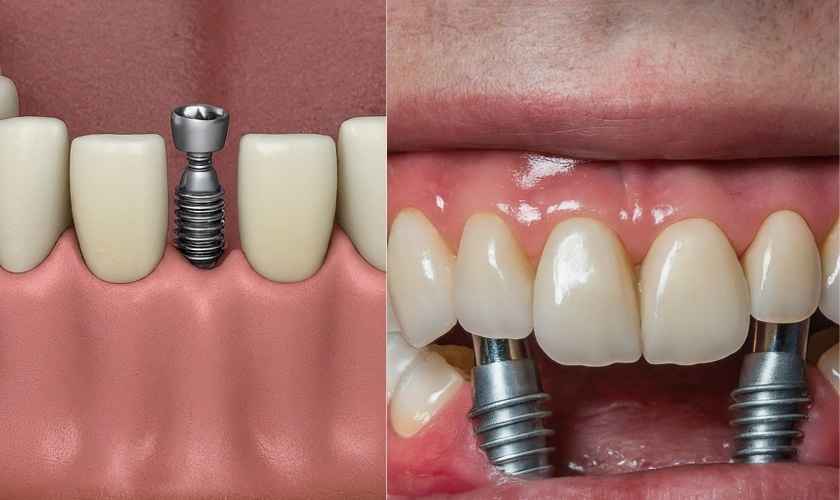Dental Sense - The Facts
Dental Sense - The Facts
Blog Article
Dental Sense Things To Know Before You Buy
Table of ContentsDental Sense for DummiesHow Dental Sense can Save You Time, Stress, and Money.The Ultimate Guide To Dental SenseThe Facts About Dental Sense Uncovered
are clinical devices surgically dental implanted right into the jaw to recover a person's capacity to eat or their look. They give support for synthetic (fake) teeth, such as crowns, bridges, or dentures. When a tooth is lost as a result of injury or condition, a person can experience problems such as quick bone loss, defective speech, or changes to chewing patterns that result in discomfort.Dental implant systems contain a dental implant body and oral implant joint and may additionally include an abutment addiction screw. Dental implant vs bridge. The dental implant body is operatively put in the jawbone in area of the tooth's root. The oral implant joint is typically affixed to the dental implant body by the joint addiction screw and prolongs with gums into the mouth to support the affixed fabricated teeth
(https://justpaste.it/hj6ob)Framework of The Dental Implant System selecting oral implants, talk with your oral provider concerning the potential advantages and risks, and whether you are a prospect for the procedure. Points to think about: Your general health is a vital variable in identifying whether you are a good candidate for oral implants, for how long it will take to recover, and for how long the implant may remain in place.
Cigarette smoking might influence the recovery process and decrease the long-term success of the dental implant. The healing procedure for the dental implant body may take a number of months or longer, during which time you typically have a short-term joint instead of the tooth. the oral implant treatment: Very carefully comply with the dental health instructions given to you by your oral service provider.
Some Known Questions About Dental Sense.
Implant failing can result in the demand for an additional procedure to take care of or replace the dental implant system. Restores the ability to eat Restores aesthetic appearance Aids maintain the jawbone from shrinking due to bone loss Preserves the health of the bordering bone and gum tissues Helps keep nearby (close-by) teeth secure Enhances quality of life Damage to bordering all-natural teeth throughout dental implant positioning Injury to the surrounding tissues throughout surgery, such as sinus opening Injury throughout surgical procedure (as an example, fracture of bordering jawbone) Inadequate feature, such as really feeling like the teeth do not attack together normally A sensation that the tooth is loosened or turning in area arising from a joint screw loosening Implant body failure (looseness of the implant body) due to systemic infection, which might be much more most likely in clients with uncontrolled diabetes due to neighborhood infection in bone and gum tissues supporting the dental implant body due to delayed healing, which might be most likely in individuals who smoke Difficulty cleaning the gums around the dental implant, causing inadequate dental health Without treatment gum disease Post-surgical tingling due to nerve impingement or damage Always alert wellness care service providers and imaging service technicians that you have oral implants prior to any kind of magnetic resonance imaging (MRI) or x-ray treatments.
FDA is not conscious of any type of adverse occasions reported for MRI or x-ray procedures with dental implants. Oral implants systems are typically made from products that comply with international consensus standards of the International Company for Standardization (ISO) or ASTM International. These requirements have information of what makes a safe material.

A dental implant is a structure that changes a missing tooth. With screw-like devices, the doctor inserts an implant right into the jawbone, and it works as an anchor for a synthetic tooth, called a crown. A device called an abutment attaches the synthetic tooth to the dental implant. The crown is personalized to fit the individual's mouth and match the shade of their teeth.
The Basic Principles Of Dental Sense
Some people are not qualified for oral implant surgical procedure. It is for oral surgeons to run on people with: acute illnessuncontrollable metabolic diseasebone or soft cells disease or infectionIf these issues are fixed, a person can have the surgery. In, oral specialists refrain from running on individuals with: If individuals with any one of the above go through oral implant surgical procedure, there is a higher risk of the implant falling short.

Oral dental implant surgical treatment is a tailored procedure. It's not the same for everybody. However the adhering to offers a general review of what you can anticipate your dental professional, oral surgeon, periodontist or prosthodontist to do: Place the implant operatively. Provide you time to heal. Attach the article and final crown, bridge or denture.
Next, your doctor will very carefully put the dental implant into your jaw. If your implant is near the front of your mouth, your dental professional will certainly make a short-lived tooth for you to wear until you recover.
Some Known Details About Dental Sense
During the healing stage, your jawbone should fuse to the dental implant. This procedure can take anywhere from three to nine months.
When your dental implant heals, your dentist can attach the abutment (tiny connector blog post) and your last reconstruction (crown, bridge or denture). This generally takes concerning one hour to finish and might call for a 2nd small surgical procedure. You shouldn't feel any kind of pain throughout your oral implant procedure due to the fact that your service provider will use medication to numb your gums.
Report this page